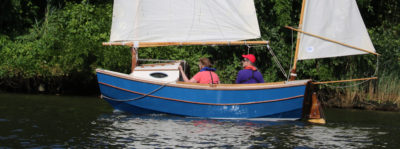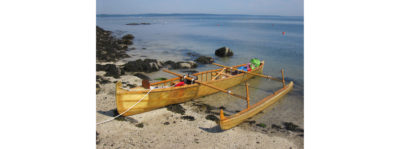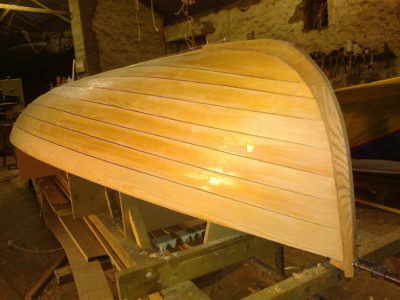 photographs courtesy of Steve Judson
photographs courtesy of Steve JudsonThe Tread Lightly’s mizzen was the feature that drew Steve to John Welsford’s design.
Steve Judson of Annapolis, Maryland, was thinking seriously about building a Scamp. His wife had given him the plans for Christmas and he had thought highly of the Scamp’s performance during a test sail. But he had his heart set on a boat with a mizzen so he could more easily heave to. He did a bit of research and discovered that John Welsford had designed another boat with a hull very much like that of the Scamp, but longer and equipped with a mizzen. Welsford’s Tread Lightly is 13′ long with a beam of 5’. That’s 13″ longer than the Scamp and 4″ narrower.

The shortened cabin leaves more room in the cockpit; eliminating the bulkhead and hatch makes access to day-sailing gear easier.
The Tread Lightly was designed with overnight cruising in mind and so it has a cabin with sitting headroom and room for a solo sailor to sleep with legs stretched out under a bench in the cockpit. Steve planned to use his boat primarily for daysailing and found his inspiration for a number of modifications to that end in Bob Trygg’s Tread Lightly, GIZMO. He shortened the cabin to provide more space in the cockpit, and eliminated the bulkhead that enclosed the cabin to make more a readily accessible space for stowing gear. Fore-and-aft benches took the place of the bridge deck in the original design; the side decks are 2″ narrower to keep them from crowding the side benches and footwell. The Tread Lightly centerboard was drawn offset to port, and Steve put his on the starboard side and pushed it a 2″ farther from the centerline to make more room in the footwell.

The step for the mizzen mast is above the tiller, allowing both the mast and the tiller to be on the centerline and not get in each other’s way. Note the yuloh’s fitting, which connects its handle to the blade of one of the two oars that were combined to make it.
He also made a few modifications of his own. He equipped the mast with a tabernacle to shorten his time at launch ramps. The tabernacle required the replacement the foredeck with an anchor well and moving the mast 3″ aft from its designed location.

Cutting the Tread Lightly’s foredeck provided clearance for the mast to pivot in its tabernacle and created a recessed well for the anchor.
Steve used recycled lumber for almost all of the solid wood parts, and even worked bits of maritime history into the construction of his Tread Lightly. He made his mooring cleats of teak from the decking of both the USCG barque EAGLE and the WWII submarine USS TORSK. A bit of Santa Maria, a wood also often used for decking, cast off from the PRIDE OF BALTIMORE II became another cleat and part of the pinrail. The pinrail also had some Osage orange from the schooner SULTANA. Steve’s brass builder’s plate is mounted on a piece of mahogany from the ferryboat GOVERNOR (formerly KULSHAN of Washington State) used by the Coast Guard when it operated a base at Governor’s Island in New York harbor.
He used less notable pieces of wood too: the boom was once a mast for a sailing dinghy, the yard is a section of a Star-class sailboat. The spars were dimensioned to fit a lugsail that Steve had on hand; its shape is slightly different than the main drawn by Welsford, but has the same area.
For auxiliary propulsion, Steve made a yuloh from a pair of 5′ oars that were too short to use on any of his other boats. A carbon-fiber ferrule joins the oars at the handles to make a 10′ long yuloh. He reshaped inboard and added a section of fiberglass tube added at a slight angle for a handle to get the proper feathering action when stroking.

Auxiliary power is provided by a yuloh fashioned from two short oars joined by ferrule. The two halves of the yuloh are easy to store aboard SYNCHRONY.
Steve launched his Tread Lightly this year, christened it SYNCHRONY, and has sailed solo and with his wife on the tidal waters of several of the rivers that feed Chesapeake Bay. He reports that the boat—beyond being easily trailered, launched, and sailed singlehanded—is a magnet for compliments.![]()
Have you recently launched a boat? Please email us. We’d like to hear about it and share your story with other Small Boats Monthly readers.












Nice. What is the angle on the Yuloh please?
Thank you! The angle between the loom and handle was about 12 degrees or so – I wasn’t being too particular about it.
You’ve made a lovely job of her Steve.
A couple of questions:
To use the yuloh, do you unhook the mainsheet, hook it out of the way (on the mizzen perhaps) or does it not get in the way?
Have you ever capsized the boat? On the SCAMP, John Welsford and Howard Rice deliberately narrowed the entry into the cuddy so that when on its side water wouldn’t get into the cuddy/cabin area. By opening up the cabin does Synchrony take on more water when on her side?